
| Toronto Maple Leafs | |
| 2012–13 Toronto Maple Leafs season | |
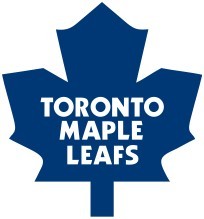 |
|
| Conference | Eastern |
| Division | Northeast |
| Founded | November 22, 1917 |
| History |
Toronto Arenas 1917 – 1919 Toronto St. Patricks 1919 – February 14, 1927 Toronto Maple Leafs February 14, 1927 – present |
| Home arena | Air Canada Centre |
| City | Toronto, Ontario |
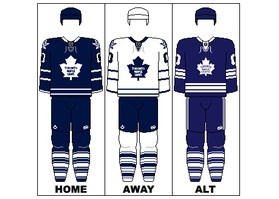 |
|
| Colours |
Blue and white |
| Media |
Leafs TV Sportsnet Ontario TSN Sportsnet 590 The Fan [1] TSN Radio 1050 |
| Owner(s) |
Maple Leaf Sports & Entertainment Ltd. (Larry Tanenbaum, chairman) |
| General manager | Dave Nonis |
| Head coach | Randy Carlyle |
| Captain | Dion Phaneuf |
| Minor league affiliates | Toronto Marlies (AHL) |
| Stanley Cups | 13 (1917–18, 1921–22,1931–32, 1941–42, 1944–45,1946–47, 1947–48, 1948–49,1950–51, 1961–62, 1962–63,1963–64, 1966–67) |
| Conference championships | 0 |
| Presidents' Trophies | 0 |
| Division championships | 5 (1932–33, 1933–34, 1934–35, 1937–38, 1999–00) |
| Official website | mapleleafs.nhl.com |
The Toronto Maple Leafs (officially the Toronto Maple Leaf Hockey Club) is a professional ice hockey franchise based in Toronto, Ontario, Canada. They are members of the Northeast Division of the Eastern Conference of the National Hockey League (NHL). The team is one of the "Original Six" league members. As of 2012 they were owned by Maple Leaf Sports & Entertainment, Ltd. and are represented by chairman Larry Tanenbaum. Their general manager is Dave Nonis. Their head coach is Randy Carlyle.In 1999 they moved to Air Canada Centre, which replaced Maple Leaf Gardens, their home since 1931.
The franchise was founded in 1917, operating simply as Toronto and known today as the Toronto Arenas, as it was operated by the Toronto Arena Company, owners of the Arena Gardens arena. In 1919, the NHL transferred the franchise to new owners who christened the team the Toronto St. Patricks. The franchise was sold in 1926 and was renamed the Toronto Maple Leaf Hockey Club. The team colours are blue and white.
The Maple Leafs have won thirteen Stanley Cup championships, second only to the twenty-four championships of their primary rival, the Montreal Canadiens. They won their last championship in 1967. The 45-year drought between championships is currently the NHL's longest. They are the only "Original Six" team which has not won the Stanley Cup championship since.
With an estimated worth of US$1 billion in 2012, the Leafs are the NHL's most valuable franchise, followed by the New York Rangers and the Montreal Canadiens, respectively.
Team history
Main article: History of the Toronto Maple Leafs
Early years
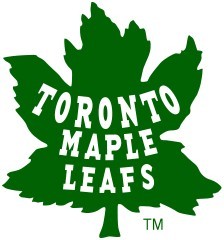
The National Hockey League was formed in 1917 in Montreal by teams formerly belonging to the National Hockey Association (NHA) that had a dispute with Eddie Livingstone, owner of the Toronto Blueshirts. The owners of the other four clubs—the Montreal Canadiens, Montreal Wanderers, Quebec Bulldogs, and Ottawa Senators—wanted to get rid of Livingstone, but discovered that the NHA constitution did not allow them to simply vote him out of the league. Instead, they opted to create a new league, the NHL, and did not invite Livingstone to join them. They also remained voting members of the NHA, and thus had enough votes to suspend the other league's operations, effectively leaving Livingstone's squad in a one-team league.
However, the other clubs felt it would be unthinkable not to have a team from Toronto (Canada's second largest city at the time) in the new league. They also needed another team to balance the schedule after the Bulldogs suspended operations (and as it turned out, would not ice a team until 1920). Accordingly, the NHL granted a "temporary" Toronto franchise to the Arena Company, owners of the Arena Gardens. The Arena Company leased the Blueshirts' players and was given until the end of the season to resolve the dispute with Livingstone. The franchise did not have an official name, but was informally called "the Blueshirts" or "the Torontos" by the fans and press. Under manager Charlie Querrie and coach Dick Carroll, the Toronto team won the Stanley Cup in the NHL's inaugural season.[6]Although the roster was composed almost entirely of former Blueshirts, the Maple Leafs do not claim the Blueshirts' history.
For the next season, rather than return the Blueshirts' players to Livingstone as originally promised, the Arena Company formed its own team, the Toronto Arena Hockey Club, which was readily granted membership in the NHL. Also that year, the Arena Company decided that only NHL teams would be allowed to play at the Arena Gardens—a move which effectively killed the NHA.[7] Livingstone sued to get his players back. Mounting legal bills from the dispute forced the Arenas to sell most of their stars, resulting in a horrendous five-win season in 1918–19. When it was obvious that the Arenas would not be able to finish the season, the NHL agreed to let the team halt operations on February 20, 1919 and proceed directly to the playoffs. The Arenas' .278 winning percentage that season is still the worst in franchise history. However, the 1919 Stanley Cup Finals ended without a winner due to the worldwide flu epidemic.
The legal dispute forced the Arena Company into bankruptcy, and it was forced to sell the team. Querrie put together a group that mainly consisted of the people who had run the senior amateur St. Patricks team in the Ontario Hockey Association. The new owners renamed the team the Toronto St. Patricks (or St. Pats for short) which would operate until 1927. The team's jersey colours changed from blue to green, winning a second Stanley Cup championship in 1922.
During this tim
e, the St. Patricks allowed other teams to play in the Arena whenever their home rinks lacked proper ice in the warmer months. At the time, the Arena was the only facility east of Manitoba with artificial ice.
Conn Smythe era
Querrie lost a lawsuit to Livingstone and decided sell the St. Pats. He gave serious consideration to a CAD 200,000 bid from a Philadelphia group. However, Toronto Varsity Graduates coachConn Smythe put together a group of his own and made a $160,000 offer. With the support of St. Pats shareholder J. P. Bickell, Smythe persuaded Querrie to accept their bid, arguing that civic pride was more important than money.
After taking control on Valentine's Day 1927, Smythe immediately renamed the team the Maple Leafs (the Toronto Maple Leafs baseball team had won the International League championship a few months earlier and had been using that name for 30 years). The Maple Leafs say that the name was chosen in honour of the Maple Leaf Regiment from World War I. As the regiment is a proper noun, its plural is Maple Leafs (not Maple Leaves). Another story says that Smythe named the team after a team he had once scouted, called the East Toronto Maple Leafs, while Smythe's grandson stated that Conn named the team after the Maple Leaf insignia he had worn during the First World War.[9] Initial reports were that the team's colours would be red and white,[10] but the Leafs wore white sweaters with a green maple leaf for their first game on February 17, 1927.[11] The next season, the Leafs appeared for the first time in the blue and white sweaters they have worn ever since. The Maple Leafs say that blue represents the Canadian skies and white represents snow, but it also followed the Toronto sports tradition of using blue as the primary colour, which started with the Toronto Argonauts in 1873 and the University of Toronto Varsity Blues in 1877 (and later the Toronto Blue Jays in 1977).
1930s: Opening of Maple Leaf Gardens
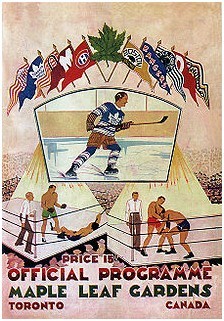
Toronto Maple Leafs opening night program at MLG, November 12, 1931
After four more lacklustre seasons (including three with Smythe as coach), Smythe and the Leafs debuted at their new arena, Maple Leaf Gardens, with a 2–1 loss to the Chicago Black Hawks on November 12, 1931.
Led by the "Kid Line" (Busher Jackson, Joe Primeau and Charlie Conacher) and coach Dick Irvin, the Leafs captured their third Stanley Cup during that season, vanquishing the Montreal Maroons in the first round, the Boston Bruins in the semifinals, and the New York Rangers in the finals. Smythe took particular pleasure in defeating the Rangers that year; he had been tapped as the Rangers' first general manager and coach in the Rangers' inaugural season (1926–27), but had been fired in a dispute with Madison Square Garden management before the season.
The Leafs' star forward, Ace Bailey, was nearly killed in 1933 when Boston Bruins defenceman Eddie Shore checked him from behind into the boards at full speed. Maple Leafs defenceman Red Horner knocked Shore out with a punch, but Bailey, writhing on the ice, had his career ended. The Leafs would hold the NHL's first All-Star Game to benefit Bailey.
The Leafs reached the Finals five times in the next seven years, but bowed out to the now-defunct Maroons in 1935, the Detroit Red Wings in 1936, the Chicago Black Hawks in 1938, Boston in 1939, and the hated Rangers in 1940. At this time, Smythe allowed Irvin to go to Montreal to help revive the then-moribund Canadiens, replacing him as coach with former Leafs captain Hap Day.
1940s: A second decade of success
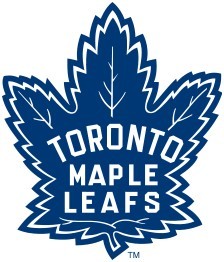
Logo (1938/39–1966/67); used on their alternate white uniforms in 2000/01–2010/11 (except in 2007/08).
In the 1942 season, the Maple Leafs were down three games to none in a best-of-seven final in the playoffs against Detroit. Fourth-line forward Don Metz then galvanized the team, coming from nowhere to score a hat-trick in game four and the game-winner in game five, with the Leafs winning both times. Captain Syl Apps had won the Lady Byng Memorial Trophy that season, not taking one penalty and finishing his ten-season career with an average of 5 minutes, 36 seconds in penalties a season. Goalie Turk Broda shut out the Wings in game six, and Sweeney Schriner scored two goals in the third period to win the seventh game 3–1.
Apps told writer Trent Frayne in 1949, "If you want me to be pinned down to my [biggest night in hockey but also my] biggest second, I'd say it was the last tick of the clock that sounded the final bell. It's something I shall never forget at all." It was the first time a major pro sports team had come back from 3–0 to win a best-of-seven championship series.
Three years later, with their heroes from 1942 dwindling (due to either age, health, or the war), the Leafs turned to lesser-known players such as rookie goalie Frank McCool and defenceman Babe Pratt. They upset the Red Wings in the 1945 finals.
The powerful defending champion Montreal Canadiens and their "Punch Line" (Maurice "Rocket" Richard, Toe Blake and Elmer Lach), were the Leafs' nemesis two years later when the two teams clashed in the1947 finals. Ted "Teeder" Kennedy scored the game-winning goal late in game six to win the Leafs their first of three straight Cups—an NHL first. With their victory in 1948, the Leafs moved ahead of Montreal for the most Stanley Cups in league history. It would take the Canadiens 10 years to reclaim the record.
1950s: The Barilko curse
The Maple Leafs and Canadiens met again in the finals in 1951, with five consecutive overtime games. Tod Sloan scored with 42 seconds left in the third period of game five to tie, and defenceman Bill Barilko, who had scored only six goals in the regular season, scored the game-winner. Barilko's glory was short-lived: he disappeared in a plane crash near Timmins, Ontario, barely four months later. The Leafs won no more Cups that decade.
1960s: New owners and a new dynasty
Before the 1961–62 season, Smythe sold nearly all of his shares in Maple Leaf Gardens to a partnership composed of his son Stafford Smythe, newspaper baron John Bassett, and Toronto Marlboros president Harold Ballard. The sale price was $2.3 million, a handsome return on Smythe's original investment 34 years earlier. Conn later claimed that he knew nothing about his son's partners, but it is very unlikely that he could have believed Stafford had raised the money on his own.
Under the new ownership, Toronto won another three straight Stanley Cups from 1962 to 1964. The team featured Hall of Famers Frank Mahovlich, Red Kelly, Johnny Bower, Dave Keon, Andy Bathgate, and Tim Horton, and was helmed by coach and general manager Punch Imlach.
In 1967, the Leafs and Canadiens met in the Cup finals for the last time to date. Montreal was considered to be a heavy favourite, but Bob Pulford scored the double-overtime winner in Game 3, Jim Pappin got the series winner in Game 6. Keon won the Conn Smythe playoff Most Valuable Player. As of 2012 the Leafs had not won the Stanley Cup (nor even made the finals) since.
In 1968, Mahovlich was traded to Detroit in a blockbuster deal, and in 1969, following a first-round playoff loss to the Bruins, Smythe fired Imlach. Horton declared, "If this team doesn't want Imlach, I guess it doesn't want me."[citation needed] He was traded to the New York Rangers the next year.
1970s and 1980s: The Ballard years
Following Stafford Smythe's death, Harold Ballard bought his shares to take control. Ballard's controversial term as the Leafs' owner was marked by several disputes with prominent players, including Keon, Lanny McDonald, and Darryl Sittler, poor win/loss records, and no championships.
During the 1970s, the overall talent level in the league was diluted by the addition of 12 franchises and the birth of the rival World Hockey Association (WHA). The Leafs iced their competition for several seasons. But despite the presence of stars such as Sittler, McDonald, Dave "Tiger" Williams, Ian Turnbull, and Borje Salming, they only once made it past the second playoff round, besting the New York Islanders (a future dynasty) in the 1978 quarters only to be swept by arch-rival Montreal in the semis. One of the few highlights from this era occurred on February 7, 1976, when Sittler scored six goals and four assists against the Bruins to establish a NHL single-game points record that still stood more than 30 years later.
The serious decline started in July 1979, when Ballard brought back Imlach, a long-time friend, as general manager. Imlach traded McDonald to undermine Imlach's friend Sittler's influence on the team.[12] Sittler himself was gone two years later, when the Leafs traded him to the Philadelphia Flyers. He was the franchise's all-time leading scorer until Mats Sundin passed him in 2007.
The McDonald trade sent the Leafs into a downward spiral. They finished five games under .500 and barely made the playoffs. For the next 12 years, the Leafs (who had shifted to the Norris Division for the 1981–82 season) were barely competitive, not posting another winning record until 1992–93. They missed the playoffs six times and finished above fourth in their division only once (in 1990, the only season where they won even half their games). They made it beyond the first round of the playoffs twice (in 1986 and 1987, advancing to the division finals). The low point came in 1984–85, when they finished 32 games under .500, the second-worst record in franchise history (their .300 winning percentage was only 22 percentage points higher than the 1918–19 Arenas).
The Leafs' poor showing resulted in several high draft picks. Future captain Wendel Clark, the first overall pick in the 1985 draft, was the lone success from the group.
Early 1990s: Resurgence
Ballard died in 1990, and Steve Stavro, Don Crump and Don Giffin were executors of his will. Calgary Flames GM Cliff Fletcher, who had crafted the Flames' 1989 championship team, was hired by Don Giffin to run the team against the objections of Stavro, who told Fletcher directly that he wanted to install his own man.
Fletcher immediately set about building a competitive club, making a series of trades and free agent acquisitions which turned the Leafs from an also-ran into a contender almost overnight, starting in 1992–93. Outstanding play from forwards Doug Gilmour (a Calgary acquaintance of Fletcher's) and Dave Andreychuk (acquired from the Buffalo Sabres in exchange for Grant Fuhr), as well as stellar goaltending from minor league call-up Felix Potvin, led the team to a then-franchise-record 99 points, third place in the Norris Division, and the eighth-best overall record in the league. Toronto dispatched the Detroit Red Wings in seven games in the first round, then defeated the St. Louis Blues in another seven games in the Division Finals.
Hoping to meet long-time rival Montreal (who was playing in the Wales Conference Finals against the New York Islanders) in the Cup Finals, the Leafs faced the Los Angeles Kings in the Campbell Conference Finals. The Leafs led the series 3–2, but dropped Game 6 in Los Angeles. The game was not without controversy, as Wayne Gretzky clipped Gilmour in the face with his stick, but referee Kerry Fraser did not call a penalty and Gretzky scored the winning goal moments later.[14] Gretzky's hat-trick in Game 7 finished the Leafs.
The Leafs had another strong season in 1993–94, finishing with 98 points, good enough for fifth overall in the league—their highest finish in 16 years. However, despite finishing one point above Calgary, Toronto was seeded third in theWestern Conference (formerly the Campbell Conference) by virtue of the Flames' Pacific Division title. The Leafs eliminated divisional rival Chicago Blackhawks in six games and the San Jose Sharks in seven before falling to the Vancouver Canucks in five games in the Western Conference Finals. At that year's draft, the Leafs packaged Clark in a trade with the Quebec Nordiques that netted them Mats Sundin.
A new home and a new millennium
In 1996, Stavro took on Larry Tanenbaum, cofounder of Toronto's new National Basketball Association (NBA) team, the Toronto Raptors, as a partner. Maple Leaf Gardens Ltd. was accordingly renamed Maple Leaf Sports & Entertainment (MLSE), to be the parent company of the two teams. MLSE has expanded since then, adding the Toronto Marlies (the Leafs' farm team) of the American Hockey League (AHL) and the Toronto FC of Major League Soccer (MLS) to its stable.
After two years out of the playoffs in the late 1990s, the Leafs acquired goaltender Curtis Joseph as a free agent from the Edmonton Oilers and signed Pat Quinn, who had been fired by Vancouver in 1997, to serve as head coach. The Leafs made another charge during the 1999 playoffs after moving from Maple Leaf Gardens to the new Air Canada Centre, shared with the Raptors. The team eliminated the Philadelphia Flyers and Pittsburgh Penguins in the first two rounds of the playoffs, but lost in five games to the Buffalo Sabres in the Eastern Conference Finals.
Toronto reached the second round in both 2000 and 2001, only to lose both times to the New Jersey Devils, who made the finals both times and won in 2000. The 2000 season was particularly notable because it marked the Leafs' first division title in 37 years, as well as the franchise's first 100-point season. The season ended on a particular low, however, when the Leafs scored just 6 shots in game six of the second round against the Devils.
In 2002, the Leafs dispatched the Islanders and their Ontario rivals, the Ottawa Senators, in the first two rounds, only to lose to the Cinderella-story Carolina Hurricanes in the Conference Finals. The 2002 season was particularly impressive in that injuries sidelined many of their better players, but the efforts of lesser-known players, led mainly by Gary Roberts and Alyn McCauley led to the conference finals.
Joseph joined the defending champion Red Wings in the 2002 off-season; the team found a replacement in veteran Ed Belfour, who came over from the Dallas Stars and had been a crucial part of their 1999 Stanley Cup run. Belfour could not carry them in the 2003 playoffs, however, as the team lost to Philadelphia in seven games in the first round. 2003 witnessed an ownership change, as Stavro sold his controlling interest in MLSE to the Ontario Teachers' Pension Plan and resigned his position as Chairman of the Board in favour of Tanenbaum. Stavro died in 2006.
The 2003–04 season started in an uncommon way for the team, as they held their training camp in Sweden and played in the NHL Challenge against teams from Sweden and Finland. That year, the Leafs had a very successful regular season, posting a franchise-record 103 points. They finished with the fourth-best record in the league (their best overall finish in 41 years) achieving a .628 win percentage, their best in 43 years and third-best in franchise history. Toronto defeated the Senators in the first round of the playoffs for the fourth time in five years, but lost to the Flyers in the second round in six.
Post-lockout era
Following the 2004–05 NHL lockout, the Leafs experienced very rough times. They struggled in 2005–06, and despite a late-season surge (9–1–2 in their final 12), led by third-string goaltender Jean-Sebastien Aubin, the Leafs were out of playoff contention for the first time since 1998. This marked the first time that the team had missed under coach Pat Quinn, and he was fired. Paul Maurice, an experienced NHL coach who had just inaugurated the Toronto Marlies, was announced as Pat Quinn's replacement. On June 30, 2006, the Maple Leafs bought out the contract of long-time fan favourite, Tie Domi. In addition to Domi, the Maple Leafs also decided against picking up the option year on the contract of goaltender Ed Belfour. Both players became free agents on July 1. However, despite the coaching change and addition of new players such as Pavel Kubina and Michael Peca, the Leafs again did not make the playoffs in 2006–07.
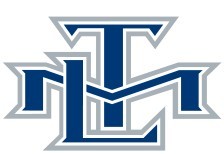
The alternate logo of the Toronto Maple Leafs, which is a monogramcontaining the acronym of the team's name
For 2007–08, the Leafs brought added Jason Blake and VesaToskala while Jeff O'Neill and J.S. Aubin left. On January 22, 2008, general manager John Ferguson, Jr. was fired and was replaced by Cliff Fletcher[15] on an interim basis. The Leafs missed again. It was the first triple miss since before even the days of the Maple Leaf Gardens. 2007–08 was Mats Sundin's last year with the Leafs.
On May 7, the Leafs fired Maurice and assistant coach Randy Ladouceur, and replaced them with former San Jose Sharks coach, Ron Wilson, and assistants Tim Hunter and Rob Zettler.
Brian Burke era
On November 29, 2008, the Maple Leafs hired Brian Burke as their 13th non-interim and first American general manager in team history. The acquisition ended the second Cliff Fletcher era and settled rumours that Burke was coming to Toronto.
On June 26, 2009, Burke made his first appearance as the Leafs GM at the 2009 NHL Entry Draft and selected Nazem Kadri with the 7th pick overall.[18] On September 18, 2009, Burke traded with the Boston Bruins for forward Phil Kessel for their first and second round Entry Draft selections in 2010, as well as a first round pick in 2011.[19] On January 31, 2010 the Leafs traded with the Calgary Flamesinvolving seven players and brought Dion Phaneuf to the Leafs.[20] On June 14, the Leafs named Dion Phaneuf as captain after two seasons without a captain following Sundin's departure.[21] On February 18, 2011, the Leafs sent long time Leaf Tomáš Kaberle to the Bruins for prospect Joe Colborne, Boston's 1st round choice in the 2011 NHL Entry Draft and a conditional 2nd round draft choice.
On March 2, 2012, Burke fired Ron Wilson and named Randy Carlyle as Head Coach.
Dave Nonis era
On January 9, 2013, Brian Burke was fired from his position as General Manager of the Maple Leafs and was replaced by Dave Nonis.[23] The 2013 season has been shortened due to a lockout.
In their first full season under the leadership of head coach Randy Carlyle, the Maple Leafs finally managed to secure a playoff berth in the shortened 2012–13 NHL season, ending an eight year absence from the playoffs. The Leafs clinched a playoff appearance with a 4-1 victory on Saturday April 20, 2013 over their provincial rivals, the Ottawa Senators. The last appearance the Leafs had in the postseason saw them get eliminated in six games during the conference semifinals of the 2004 Stanley Cup playoffs, at the hands of the Philadelphia Flyers. Before the 2013 season, the Leafs remained the only NHL team that had not qualified for the playoffs since the 2005 NHL lockout. They had sharedthe distinction with the Florida Panthers before the latter qualified in 2012.
Logo, uniform and mascot
The jersey of the Toronto Maple Leafs has a long history and is one of the best-selling NHL jerseys among fans.[24] Over the years the Leaf uniform has had four major incarnations and numerous minor alterations.
The original 1917 blue uniforms featured the letter “T” sometimes on a blue shield. The second version came in 1919 when they were renamed the St. Pats and wore green uniforms with “Toronto St. Pats” on the logo, lettered in green either on a white “pill” shape or stripes.
The third major change was for the 1927–28 season when the team’s name changed to the Maple Leafs, gaining a new logo and returning to the blue uniform. The logo was a 47-point maple leaf with “Toronto Maple Leafs” lettered in white. The home jersey was blue with alternating thin-thick stripes on the arms, legs and shoulders. The road uniform was white with three stripes on the chest and back, waist and legs. For 1933–34, the alternating thin-thick stripes were replaced with stripes of equal thickness. This would remain as the basic design for the next forty years.
Before the next major change came several minor changes. In 1937, veins were added to the leaf and “Toronto” curved downwards at the ends instead of upwards.[25] In 1942, the 35-point leaf was introduced. In 1946, the logo added trimming to the Leaf with a white or blue border, while “C” for captain and “A” for alternate captain first appeared on the sweaters. In 1947, the logo’s “Toronto Maple Leafs” was lettered in red for a short time. In 1958, a six-eyelet lace and tie was added to the neck and a blue shoulder yoke was added. In 1961, player numbers added appeared on the sleeves.
The fourth major change came in the 1966–67 season. The leaf was changed to a blue 11-point leaf, similar to the leaf on the Canadian flag to commemorate the Canadian centennial.[26] This was followed by many minor changes. In 1970, the League required home teams to wear white jerseys. Other changes to the sweater removed the arm stripes, extended the yoke to the end of the sleeves,[26] added a solid stripe on the waist, three stripes on the stockings and a miniature Leaf crest added to shoulders. On the logo the lettering “Toronto” was no longer curved, but parallel to the “Maple Leafs” lettering. The Thin blue 11-point maple leaf had rounded corners. In 1973, the jersey’s neck was a lace tie-down design. In 1976, the V-neck returned. In 1977, player names were added to the away jerseys and in 1979 to the home jerseys, but not until after the Leafs were fined by the NHL for refusing to comply with a new rule requiring player names on the jerseys.
Since the early 1990s, fans showed interest in past jersey designs. For the 1991–92 season, the Leafs wore uniforms that were styled after the “original six” era for some games. For the 1992–93 season, due to enthusiastic fan reaction for the previous season's classic uniforms, the first changes to the Leaf uniform in over 20 years were made. Two stripes on the arms and waist were added. A “TML” logo added to the shoulder. During the late 1990s, the lettering and numbers were taken from the font on the Maple Leafs logo, but they gradually returned to block lettering, which they fully integrated in the 2010–11 season. When the Reebok EDGE uniform system was introduced in the 2007–08 season, the tail stripes were absent from the change, but returned three years later. In addition, the veined leaf logo returned to the uniforms.
The team mascot is Carlton the Bear, an anthropomorphic polar bear whose name and number (#60) comes from the location of Maple Leaf Gardens at 60 Carlton Street, where they played throughout much of their history.



















